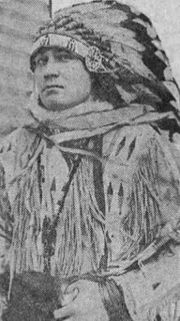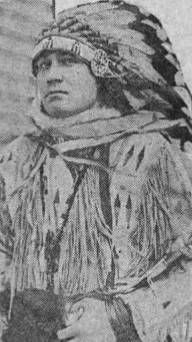Acee Blue Eagle facts for kids
Quick facts for kids
Acee Blue Eagle
|
|
|---|---|
| Chebon Ahbulah (Laughing Boy), Lumhee Holot-Tee (Blue Eagle) | |
 |
|
| Born |
Alexander C. McIntosh
August 16, 1907 North of Anadarko, Territory of Oklahoma
|
| Died | June 18, 1959 (aged 51) |
| Resting place | National Cemetery, Fort Gibson, Oklahoma |
| Nationality | Muscogee (Creek) Nation |
| Education | Bacone College, University of Oklahoma, |
| Alma mater | University of Oklahoma |
| Occupation | Artist, educator, dancer, and Native American flute player. |
| Employer | Bacone College, self |
| Organization | United States Army Air Corps, Bacone College |
| Known for | Directing the art program at Bacone College |
|
Notable work
|
Murals in the dining hall of the USS Oklahoma (BB-37) and U.S. Post Office at Seminole, Oklahoma |
| Style | Bacone style |
| Spouse(s) | Second wife, Balinese dancer, Devi Dja |
| Partner(s) | Mae Wadley Abbott |
| Parent(s) | Solomon McIntosh, mother was Martha "Mattie" Odom |
| Relatives | Second cousin, Muscogee/Seminole artist Fred Beaver; cousin, Howard Rufus Collins, who painted under the name Ducee Blue Buzzard |
| Awards | Indian Hall of Fame, Who's Who of Oklahoma, International Who's Who, "Outstanding Indian in the United States", 1958; received a medal for eight paintings at the National Museum of Ethiopia |
Acee Blue Eagle (born August 17, 1907 – died June 18, 1959) was a famous Native American artist. He was also a teacher, dancer, and played the Native American flute. He led the art program at Bacone College. His birth name was Alexander C. McIntosh. He was also known as Chebon Ahbulah (Laughing Boy) and Lumhee Holot-Tee (Blue Eagle). He was a member of the Muscogee (Creek) Nation.
Contents
Becoming an Artist and Educator
Alexander C. McIntosh was born near Anadarko, Oklahoma. This was on August 17, 1907. His father was Solomon McIntosh. His mother was Martha "Mattie" McIntosh. His great-grandfather was a Muscogee Creek chief for many years.
Blue Eagle went to several schools. He studied at Haskell Institute in Kansas. Then he went to Chilocco Indian Agricultural School. He finished high school there in 1928. He started college at Bacone College in Muskogee. He later earned his art degree from the University of Oklahoma (OU) in 1932. At OU, he learned painting from Oscar B. Jacobson. Jacobson was known for a style called "Flatstyle" painting.
Blue Eagle also served his country. He was in the United States Army Air Corps. This was during World War II. He served for three years.
Teaching Art at Bacone College
In 1935, Blue Eagle joined Bacone College. He became the head of the art department. He led the program until 1938. He helped create the unique Bacone style of painting. He also helped the art department grow. After the war, he taught at Oklahoma State Technical School. This school was in Okmulgee.
Blue Eagle's Art Career
Acee Blue Eagle's art was very special. His work was even shown at the 1932 Summer Olympics. It was part of the painting event.
In 1935, Blue Eagle was invited to England. He gave talks about American Indian art. These talks were at Oxford University. By 1938, his art was famous across the country. He had his own art show in New York City. This was at the Grand Central Art Galleries.
His art was shown in many places. From 1936 to 1937, a museum in Norman showed his watercolors. This was the Fred Jones Jr. Museum of Art. In the 1940s, he made art for his friend, Thomas Gilcrease. Gilcrease was a collector. Blue Eagle became famous worldwide. His paintings are now in galleries everywhere.
Famous Murals
Blue Eagle was well known for painting large murals. These are big paintings on walls. Some of his murals are still in Oklahoma today. He made them for the New Deal art projects. These projects helped artists during tough times. In 1934, he joined the Public Works of Art Project. One of his murals was in the dining hall of the USS Oklahoma (BB-37).
He also painted murals for colleges. He made two murals for classrooms. These were at the University of Science and Arts of Oklahoma. He painted murals at other Oklahoma colleges too. These included the University of Central Oklahoma and Northeastern State University.
Blue Eagle also painted murals for post offices. He painted them in Seminole, Oklahoma (1939) and Coalgate, Oklahoma (1942). Another artist, Fred Beaver, fixed the Coalgate mural in 1965. Blue Eagle's art was part of a big show. It was called Stretching the Canvas. This show was at the National Museum of the American Indian.
Awards and Honors
Acee Blue Eagle received many awards. He was chosen for the Indian Hall of Fame. He was also in Who's Who of Oklahoma. He was even in the International Who's Who. In 1958, he was named "Outstanding Indian in the United States."
He received a special medal. This was for eight paintings. They were shown at the National Museum of Ethiopia. The Emperor Haile Selassie I gave him this medal. Another artist, Charles Banks Wilson, said Blue Eagle was like the "Dale Carnegie of Indian Art." An art historian, Jeanne O. Snodgrass, said Blue Eagle was the "foundation in Indian Art" for Oklahoma.
Family and Legacy
Blue Eagle had family members who were also artists. His cousin was the painter Solomon McCombs. Another cousin, Howard Rufus Collins, painted under the name Ducee Blue Buzzard. This name was a playful nod to Acee's name.
Acee Blue Eagle passed away on June 18, 1959. He is buried in the National Cemetery. This cemetery is in Fort Gibson, Oklahoma. A book about his life was published in 2006. It is called Lumhee Holot-tee: The Art and Life of Acee Blue Eagle. At Haskell Indian Nations University, a building is named Blue Eagle Hall. This honors his memory and contributions.


